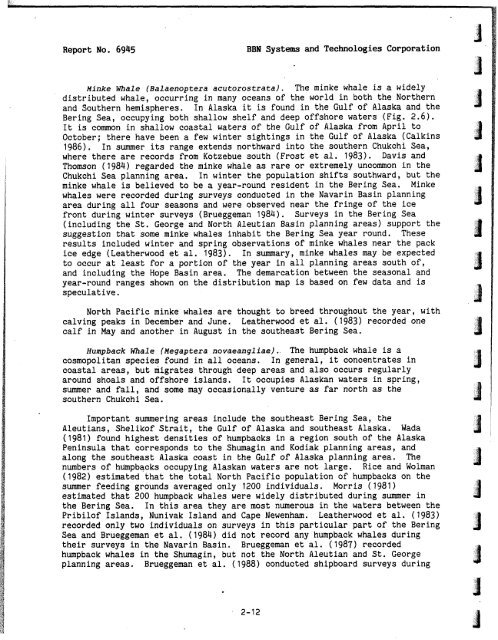Analysis and Ranking of the Acoustic Disturbance Potential of ...
Analysis and Ranking of the Acoustic Disturbance Potential of ...
Analysis and Ranking of the Acoustic Disturbance Potential of ...
Create successful ePaper yourself
Turn your PDF publications into a flip-book with our unique Google optimized e-Paper software.
Report No. 6945<br />
BBN Systems <strong>and</strong> Technologies Corporation<br />
Minke Whale (Balaenoptera acutorostrata). The minke whale is a widely<br />
distributed whale, occurring in many oceans <strong>of</strong> <strong>the</strong> world in both <strong>the</strong> Nor<strong>the</strong>rn<br />
<strong>and</strong> Sou<strong>the</strong>rn hemispheres. In Alaska it is found in <strong>the</strong> Gulf <strong>of</strong> Alaska <strong>and</strong> <strong>the</strong><br />
Bering Sea, occupying both shallow shelf <strong>and</strong> deep <strong>of</strong>fshore waters (Fig. 2.6).<br />
It is common in shallow coastal waters <strong>of</strong> <strong>the</strong> Gulf <strong>of</strong> Alaska from April to<br />
October; <strong>the</strong>re have been a few winter sightings in <strong>the</strong> Gulf <strong>of</strong> Alaska (Calkins<br />
1986). In summer its range extends northward into <strong>the</strong> sou<strong>the</strong>rn Chukchi Sea,<br />
where <strong>the</strong>re are records from Kotzebue south (Frost et al. 1983). Davis <strong>and</strong><br />
Thomson (1984) regarded <strong>the</strong> minke whale as rare or extremely uncommon in <strong>the</strong><br />
Chukchi Sea planning area. In winter <strong>the</strong> population shifts southward, but <strong>the</strong><br />
minke whale is believed to be a year-round resident in <strong>the</strong> Bering Sea. Minke<br />
whales were recorded during surveys conducted in <strong>the</strong> Navarin Basin planning<br />
area during all four seasons <strong>and</strong> were observed near <strong>the</strong> fringe <strong>of</strong> <strong>the</strong> ice<br />
front during winter surveys (Brueggeman 1984). Surveys in <strong>the</strong> Bering Sea<br />
(including <strong>the</strong> St. George <strong>and</strong> North Aleutian Basin planning areas) support <strong>the</strong><br />
suggestion that some minke whales inhabit <strong>the</strong> Bering Sea year round. These<br />
results included winter <strong>and</strong> spring observations <strong>of</strong> minke whales near <strong>the</strong> pack<br />
ice edge (Lea<strong>the</strong>rwood et al. 1983). In summary, minke whales may be expected<br />
to occur at least for a portion <strong>of</strong> <strong>the</strong> year in all planning areas south <strong>of</strong>,<br />
<strong>and</strong> including <strong>the</strong> Hope Basin area. The demarcation between <strong>the</strong> seasonal <strong>and</strong><br />
year-round ranges shown on <strong>the</strong> distribution map is based on few data <strong>and</strong> is<br />
speculative.<br />
North Pacific minke whales are thought to breed throughout <strong>the</strong> year, with<br />
calving peaks in December <strong>and</strong> June. Lea<strong>the</strong>rwood et al. ( 1983) recorded one<br />
calf in May <strong>and</strong> ano<strong>the</strong>r in August in <strong>the</strong> sou<strong>the</strong>ast Bering Sea.<br />
Humpback Whale (Megaptera novaeangliae). The humpback whale is a<br />
cosmopolitan species found in all oceans. In general, it concentrates in<br />
coastal areas, but migrates through deep areas <strong>and</strong> also occurs regularly<br />
around shoals <strong>and</strong> <strong>of</strong>fshore isl<strong>and</strong>s. It occupies Alaskan waters in spring,<br />
summer <strong>and</strong> fall, <strong>and</strong> some may occasionally venture as far north as <strong>the</strong><br />
sou<strong>the</strong>rn Chukchi Sea.<br />
Important summering areas include <strong>the</strong> sou<strong>the</strong>ast Bering Sea, <strong>the</strong><br />
Aleutians, Shelik<strong>of</strong> Strait, <strong>the</strong> Gulf <strong>of</strong> Alaska <strong>and</strong> sou<strong>the</strong>ast Alaska. Wada<br />
(1981) found highest densities <strong>of</strong> humpbacks in a region south <strong>of</strong> <strong>the</strong> Alaska<br />
Peninsula that corresponds to <strong>the</strong> Shumagin <strong>and</strong> Kodiak planning areas, <strong>and</strong><br />
along <strong>the</strong> sou<strong>the</strong>ast Alaska coast in <strong>the</strong> Gulf <strong>of</strong> Alaska planning area. The<br />
numbers <strong>of</strong> hmpbacks occupying Alaskan waters are not large. Rice <strong>and</strong> Wolman<br />
(1982) estimated that <strong>the</strong> total North Pacific population <strong>of</strong> humpbacks on <strong>the</strong><br />
summer feeding grounds averaged only 1200 individuals. Morris (1981)<br />
estimated that 200 humpback whales were widely distributed during summer in<br />
<strong>the</strong> Bering Sea. In this area <strong>the</strong>y are most numerous in <strong>the</strong> waters between <strong>the</strong><br />
Pr ibil<strong>of</strong> Isl<strong>and</strong>s, Nunivak Isl<strong>and</strong> <strong>and</strong> Cape Newenham. Lea<strong>the</strong>rwood et a1 . ( 1983)<br />
recorded only two individuals on surveys in this particular part <strong>of</strong> <strong>the</strong> Bering<br />
Sea <strong>and</strong> Brueggeman et al. (1984) did not record any humpback whales during<br />
<strong>the</strong>ir surveys in <strong>the</strong> Navarin Basin. Brueggeman et al. (1987) recorded<br />
humpback whales in <strong>the</strong> Shumagin, but not <strong>the</strong> North Aleutian <strong>and</strong> St. George<br />
planning areas. Brueggeman et al. (1988) conducted shipboard surveys during
















